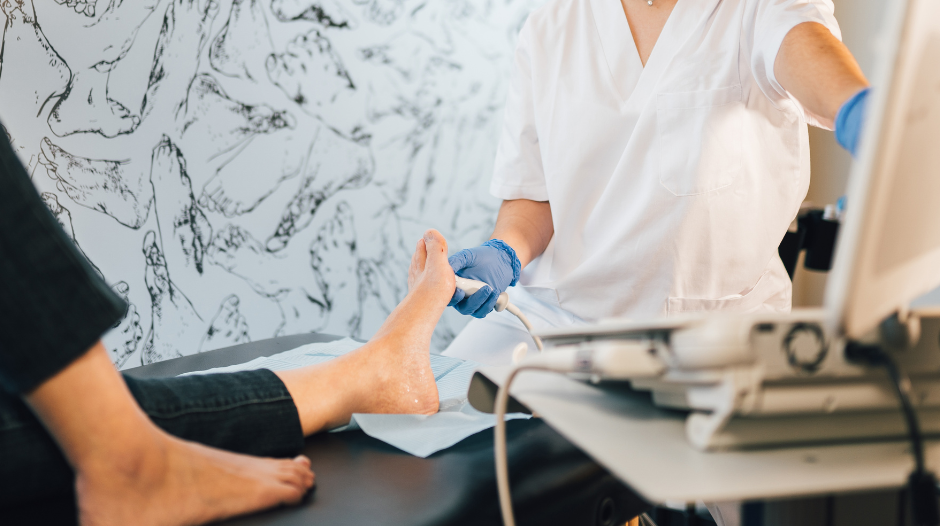Understanding Ultrasound: A Podiatrist’s Perspective
In some ways, ultrasound technology has changed the field of podiatry significantly, providing valuable insights and diagnostics that would normally be more difficult to glimpse. At Northern Ankle Foot Associates, we make frequent use of this non-invasive imaging technique.
There are quite a few misconceptions and misunderstandings surrounding this technology, so in this blog post, we’ll explore the applications of ultrasound in podiatry, including ultrasound-guided needle injections and ultrasound diagnostics.
When is Ultrasound Appropriate?
Ultrasound is a valuable tool for podiatrists and can be used in various situations, including:
- When traditional imaging methods are inconclusive, ultrasound can provide additional information that may not be visible on X-rays or MRIs.
- To diagnose soft tissue injuries, identifying conditions that may not be apparent in other imaging studies.
- To guide injections, ensuring accurate placement of needles for targeted treatments.
What kind of injections? That depends on the problem.
Ultrasound-Guided Needle Injections
This technique involves using ultrasound to visualize the target area and ensure accurate placement of the needle.
- It’s also quite popular with foot and ankle experts: some surveys suggest that70% of respondents use it as a part of their practice.
- Enhanced precision reduces the risk of complications and improves the effectiveness of the treatment: a review published in The Orthopedic Journal of Sports Medicine determined that while non-ultrasound “landmark” injection accuracy ranged from 58% to 85%, ultrasound guidance for foot and ankle procedures increased accuracy to 100%.
What They Treat and How They Work
Good podiatric medicine is catered to the patient and their unique needs. That said, ultrasound-guided injections are quite useful for a variety of different foot and ankle ailments. Most of them make use of cortisone or corticosteroids targeting specific areas of inflammation, such as the ankle joint or metatarsalgia. And they can often provide lasting and significant pain relief.
- In the previously mentioned studies, a majority of patients who received ultrasound-guided midfoot corticosteroid injections experienced symptom relief 3 months after treatment.
- The results of these studies prompted the American Medical Society for Sports Medicine to create a position statement officially supporting the use of ultrasound guidance in lower extremity joint injections.
Patients often appreciate the effects of guided injections for issues like plantar fasciitis, asinjecting corticosteroids into the plantar fascia can help reduce inflammation and pain.
They can also be used to treat ganglion cysts, assisting the process of aspirating fluid from the cysts to alleviate symptoms and reduce their size.
Ultrasound Diagnostics
Ultrasound can also be used for diagnostic purposes, and for many podiatrists, that is their primary function. By examining the soft tissues of the foot, podiatrists using ultrasound can identify and diagnose various conditions, including:
- Stress fractures, detecting subtle breaks that may not be visible on X-rays.
- Tendonitis, assessing the inflammation and swelling of tendons.
- Neuromas, identifying nerve compression between the toes.
- Foreign bodies, locating objects that may have become embedded in the foot.
Common Misconceptions
There are some misconceptions about ultrasound that are worth addressing:
- Are They Painful? No. Ultrasound procedures are generally painless and do not involve any radiation exposure.
- Do They Have Limited Applications? Far from it. Ultrasound is a versatile tool that can be used to diagnose and treat a wide range of foot and ankle conditions.
- Are They Expensive? While ultrasound technology may have been more costly in the past, it has become more affordable and accessible in recent years due in part to technological improvements alongside the popularity of new tools and handheld options.
Technology is only one piece of the treatment puzzle, but ultrasound has proven uniquely valuable in more ways than one. We hope the information above has cleared up its use and given you an idea of just how helpful it really is.
Do any of the podiatric problems we’ve mentioned sound familiar? Do you think ultrasound might be right for you? If so, please reach out to Northern Ankle Foot Associates and contact us today. Dr. Robyn Joseph would be happy to help.


